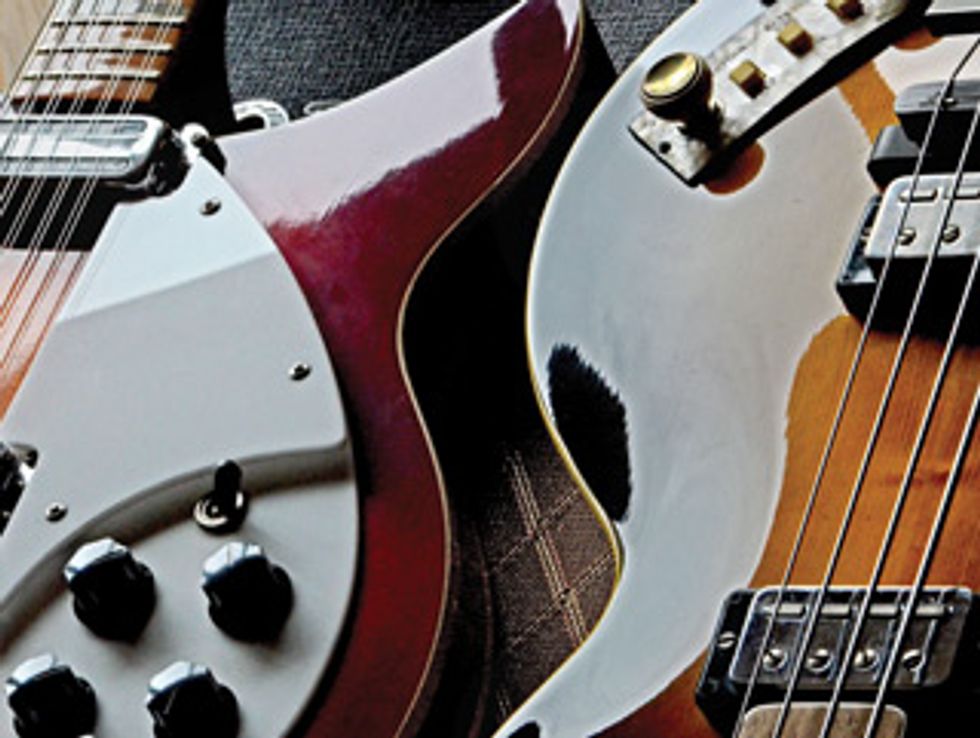There have always been commercial products vying for consumer dollars via the lowest common denominator, and musical instruments are no exception.

Fab tone machines: Rickenbacker 12-string, Hofner violin bass, and, of course, a Vox amp.
Picture this: I’m at the gym and lying on my back while going through some exercises with a trainer. My eyes are closed, I’m concentrating, and I’m attempting to block out the cacophony around me. Clanging machines and the high-pitched voices of young women chatting about bridesmaid dresses and cosmetics weave in and out of “Good Time” by Owl City and Carly Rae Jepsen playing on the gym’s stereo system. As quickly as it comes, it’s gone, segueing into “Hey Ya!” from Outkast. As much as I like the song, I find it hard to determine where the tune ends and the room noise begins.
Astonishingly, next up is “Fire” by Jimi Hendrix, a markedly different sort of soundscape and delivery. Of course, Jimi knew how to shake it like a Polaroid in his own way, but the contrast made me wonder when music started to sound like the producer set up a microphone on a playground and merely hit the record button. The answer is, most likely, a long time ago. A quick scan of pop hits from decades past yields endless examples of jump-rope singalongs put to a beat.
There have always been commercial products vying for consumer dollars via the lowest common denominator, and musical instruments are no exception. As television began to beam images of guitar-playing heroes like Gene Autry, Roy Rogers, and Merle Travis, the 6-string’s stock began to rise. This exposure helped manufacturers advertise their association with leading artists beyond the music store crowd in a big way.
But the real tipping point must have been in February of 1964 when the Beatles appeared before 73 million viewers on The Ed Sullivan Show. The group’s less than threatening, la-di-da rendition of “All My Loving” was one of the first in a long line of hummable pop songs to follow from England, as if Chuck Berry and Buck Owens had echoed off their shores. The difference was the atomic-bomb magnitude of the reaction to a guitar-powered group. If the Beach Boys, Ventures, or Hank Marvin’s Shadows hadn’t convinced young folks to plug in a guitar, this moment in time was a twangy tsunami of motivation for would-be rockers. The accordion and saxophone just didn’t stand a chance. The guitar became the teenage weapon of choice almost overnight, and instrument manufacturers geared up for a ride that continues to this day.
In some way, this was also the moment the vintage guitar market was quietly launched. At the time, the guitar and amplifier industry was a cottage industry at best. Musical gear was primarily made in small quantities by hand, and closely linked to the individuals who designed and created them. Even the biggest of the big were not much more than family businesses. John Hall, the present-day, second-generation owner of Rickenbacker, fondly recalls the story of his father personally delivering a new 12-string electric to George Harrison when the Beatle was staying at The Park hotel in New York.
The first round of shots had been fired in the ensuing guitar wars, and the resulting manufacturing ramp-up was spectacular. It would leave almost no guitar-oriented enterprise untouched. Vox amplifiers were in such demand that their U.S. agent, Thomas Organ, was compelled to build product stateside under license in order to meet demand. Gibson built a vast, modern facility behind their original, brick structure on Parsons Street. And Fender, the quintessential family business, expanded to the point where they attracted no less than CBS as a buyer in 1965. Although the corporate payout was a staggering 13 million bucks, it was just a fraction of what lay ahead. It also marked a watershed for the industry as a whole. Who hasn’t heard the phrase “pre- CBS” when describing a choice, vintage Fender? Although we can point to a generally raised level of quality today, especially at the entry level, it was this very expansion and the ensuing corner-cutting that underwrote our vintage and boutique sensibilities.
In a continuation of market expansion, the idea of throwaway guitars is upon us. Just like the disposable pop music that saturates our culture (and then disappears only to quickly be replaced by another wave) the instrument market is fashion driven. By that, I mean not only the allure of airbrushed graphics or fancy tonewoods, but also the very way these guitars are presented to us. Do we really need another hyperbolic phrase to describe what is essentially a Stratocaster? Tom Petty sings about this in his song “Joe” from The Last DJ album—it’s almost as if you could substitute the word “gear” for “music.”
The idea of cheap, mass-produced/marketed instruments has been as good for musicians starting out as the concept of handmade, heirloom instruments has been for the truly inspired buyer. You can’t have one without the other. But, not all is lost. This is just one man’s musing about the state of popular culture. And as I finish my workout routine, the rush of endorphins and the loping beat of Katy Perry’s “Wide Awake” give me a hopeful feeling as I stride out the door. There’s room in this world for all types of experience and everything doesn’t need to be so serious.
I feel like building a Tele.
 Jol Dantzig is a
noted designer, builder,
and player who co-founded
Hamer Guitars,
one of the first boutique
guitar brands, in 1973.
Today, as the director of
Dantzig Guitar Design, he continues to
help define the art of custom guitar. To
learn more, visit guitardesigner.com.
Jol Dantzig is a
noted designer, builder,
and player who co-founded
Hamer Guitars,
one of the first boutique
guitar brands, in 1973.
Today, as the director of
Dantzig Guitar Design, he continues to
help define the art of custom guitar. To
learn more, visit guitardesigner.com.

